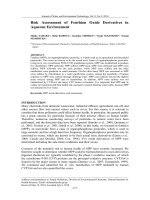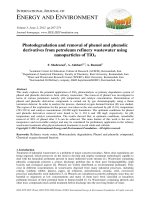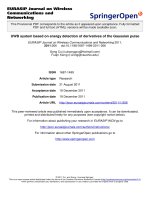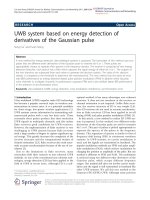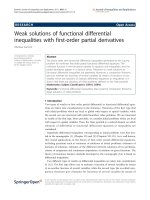Carboxyl Derivatives pps
Bạn đang xem bản rút gọn của tài liệu. Xem và tải ngay bản đầy đủ của tài liệu tại đây (2.87 MB, 68 trang )
An acid
chloride An es ter
An acid
anhydride
O
O
RCCl RCOR'RCOCR'
O
RC- OH H- Cl
O
RC- OH H- OCR'
O
RC- OH H- OR'
O
O
O
An amide A nitrile
O
RC NRCNH
2
O
RC- OH H- NH
2
RC= N
HO H
The enol of
an amide
RC-
O
RCCl
O
CH
3
CCl
O
CCl
O
ClC(CH
2
)
4
CCl
OO
Benzoyl
chloride
Ethanoyl chloride
(Acetyl chlorid e)
An acyl ch loride
(An acid chloride)
An acyl
group
Hexanedioyl chloride
(Adipoyl ch loride)
replacement of -OH in a sulfonic acid by -Cl gives
a sulfonyl chloride
SOHH
3
C
O
O
CH
3
SOH
O
O
SClH
3
C
O
O
CH
3
SCl
O
O
Methanes ulfon ic
acid
p-Toluenesulfon ic
acid
Methanes ulfonyl chloride
(Mesyl chloride, MsCl)
p-Toluenesulfon yl chloride
(Tosyl chloride, TsCl)
The functional group of an acid anhydride is two
acyl groups bonded to an oxygen atom
the anhydride may be symmetrical (two identical
acyl groups) or mixed (two different acyl groups)
to name, replace
acid
acid of the parent acid by
anhydride
anhydride
Acetic benz oic
anhydride
Benz oic anhydride
Acetic anhydride
COC
CH
3
COCCH
3
CH
3
COC
OO
O
O
O
O
Cyclic anhydrides are named from the
dicarboxylic acids from which they are derived
Maleic
anhydride
O
O
O
Phthalic
anhydride
Succinic
anhydride
O
O
O
O
O
O
The functional group of an ester is an acyl
group bonded to -OR or -OAr
name the alkyl or aryl group bonded to oxygen
followed by the name of the acid
change the suffix
-ic acid
-ic acid to
-ate
-ate
Ethyl ethanoate
(Ethyl acetate)
Diethyl butanedioate
(Diethyl succinate)
O
O
O
O
O
O
O
O
Is opropyl
benz oate
Cyclic esters are called lactones
name the parent carboxylic acid, drop the suffix
-ic
-ic
acid
acid, and add
-olactone
-olactone
5-Hexanolacton e
(δ-Caprolacton e)
4-Bu tanolactone
(γ-Bu tyrolacton e)
3-Bu tanolactone
(β-Butyrolactone)
δ
β
α
γβ
α
β
α
γ
O
O
O
O
O
O
H
3
C
CH
3
2
3
1
2
2
1
3
1
3 4
4
5
The functional group of an amide is an acyl
group bonded to a nitrogen atom
IUPAC: drop -
oic acid
oic acid from the name of the parent
acid and add
-amide
-amide
if the amide nitrogen is bonded to an alkyl or aryl
group, name the group and show its location on
nitrogen by
N-
N-
N-Methylacetamide
(a 2° amide)
Acetamide
(a 1° amide)
CH
3
CNH
2
CH
3
CNHCH
3
HCN( CH
3
)
2
N,N-Dimethyl-
formamide (DMF)
(a 3° amide)
O O O
Cyclic amides are called lactams
Name the parent carboxylic acid, drop the
suffix
-ic acid
-ic acid and add
-lactam
-lactam
α
β
γ
δ
ε
6-Hexanolactam
(ε-Caprolactam)
α
β
H
3
C
O
NH
O
NH
1
2
1
2
3
4
5
6
3
3-Butanolactam
(β-Butyrolactam)
The functional group of a nitrile is a cyano
group
IUPAC: name as an
alkanenitrile
alkanenitrile
Common: drop the
-ic acid
-ic acid and add
-onitrile
-onitrile
CH
3
C N C N
CH
2
C N
Ethanenitrile
(A cetonitrile)
Benzonitrile Phenylethanenitrile
(Phenylacetonitrile)
Amides are comparable in acidity to alcohols
water-insoluble amides do not react with NaOH or
other alkali metal hydroxides to form water soluble
salts
Sulfonamides and imides are more acidic than
amides
CH
3
CNH
2
O
NH
O
O
NH
O
O
O
SNH
2
O
pK
a
8.3
pK
a
9.7pK
a
10
PhthalimideSuccinimideBenzen esulfonamide
Acetamide
p K
a
15-17
Imides are more acidic than amides because
1. the electron-withdrawing inductive of the two
adjacent C=O groups weakens the N-H bond, and
2. the imide anion is stabilized by resonance
delocalization of the negative charge
Phthalimide A resonance-stabiliz ed anion
+
N-H
O
O O
O
N
-
N
O
-
O
H
3
O
+
+
H
2
O
imides such as phthalimide readily dissolve in
aqueous NaOH as water-soluble salts
(stronger
acid)
(weaker
acid)
(weaker
base)
(stronger
bas e)
pK
a
15.7pK
a
8.3
+
+
O
O
NH N
-
Na
+
O
O
NaOH H
2
O
Additional
Stretchings (cm
-1
)
O-H at 2400-3400
C-O at 1210-1320
(2° have one N-H peak)
(1° have two N-H peaks)
N-H at 3200 and 3400
C-O at 900-1300
C-O at 1000-1100
and 1200-1250
(cm
-1
)
C=O Stretch
1740-1760
and
1800-1850
1630-1680
1735-1800
1700-1725
O
O
O
O
RCOH
RCOCR
RCOR
RCNH
2
Cmpd
O
1
H-NMR
H on the α-carbon to a C=O group are slightly
deshielded and come into resonance at δ 2.1-2.6
H on the carbon of the ester oxygen are more
strongly deshielded and come into resonance at δ
3.7-4.7
13
C-NMR
the carbonyl carbons of esters show characteristic
resonance at δ 160-180
Methyl propanoate
δ 3.68(s)
δ 2.33(q)
O
CH
3
-CH
2
-C-O-CH
3
Nucleophilic acyl substitution:
Nucleophilic acyl substitution: an addition-
elimination sequence resulting in substitution
of one nucleophile for another
Tetrahedral carbonyl
addition intermediate
-
-
++
C
NuR
C
Y
R
Y
O
O
-
Nu Y
Subs titution
product
:
:
:
R
C
Nu
O
in this general reaction, we have shown the leaving
group as an anion to illustrate an important point
about them: the weaker the base, the better the
leaving group
Increasing basicity
Increasing leaving ability
X
-
RO
-
R
2
N
-
RCO
-
O
halide ion is the weakest base and the best leaving
group; acid halides are the most reactive toward
nucleophilic acyl substitution
amide ion is the strongest base and the poorest
leaving group; amides are the least reactive toward
nucleophilic acyl substitution
O
RCX
RCOCR'RCOR'RCNH
2
Increasing reactivity toward nucleophilic acyl substitution
Amide Ester
Anhydride
Acid halide
O
O O
O
low-molecular-weight acid chlorides react rapidly
with water
higher molecular-weight acid chlorides are less
soluble in water and react less readily
+
+
O
O
CH
3
CCl H
2
O
CH
3
COH HCl
low-molecular-weight acid anhydrides react readily
with water to give two molecules of carboxylic acid
higher-molecular-weight acid anhydrides also react
with water, but less readily
CH
3
COCCH
3
O O
H
2
O
CH
3
COH
O
O
HOCCH
3
++
Esters are hydrolyzed only slowly, even in
boiling water
Hydrolysis becomes more rapid if they are
heated with either aqueous acid or base
Hydrolysis in aqueous acid is the reverse of
Fischer esterification
the role of the acid catalyst is to protonate the
carbonyl oxygen and increase its electrophilic
character toward attack by water to form a
tetrahedral carbonyl addition intermediate
collapse of this intermediate gives the carboxylic
acid and alcohol
